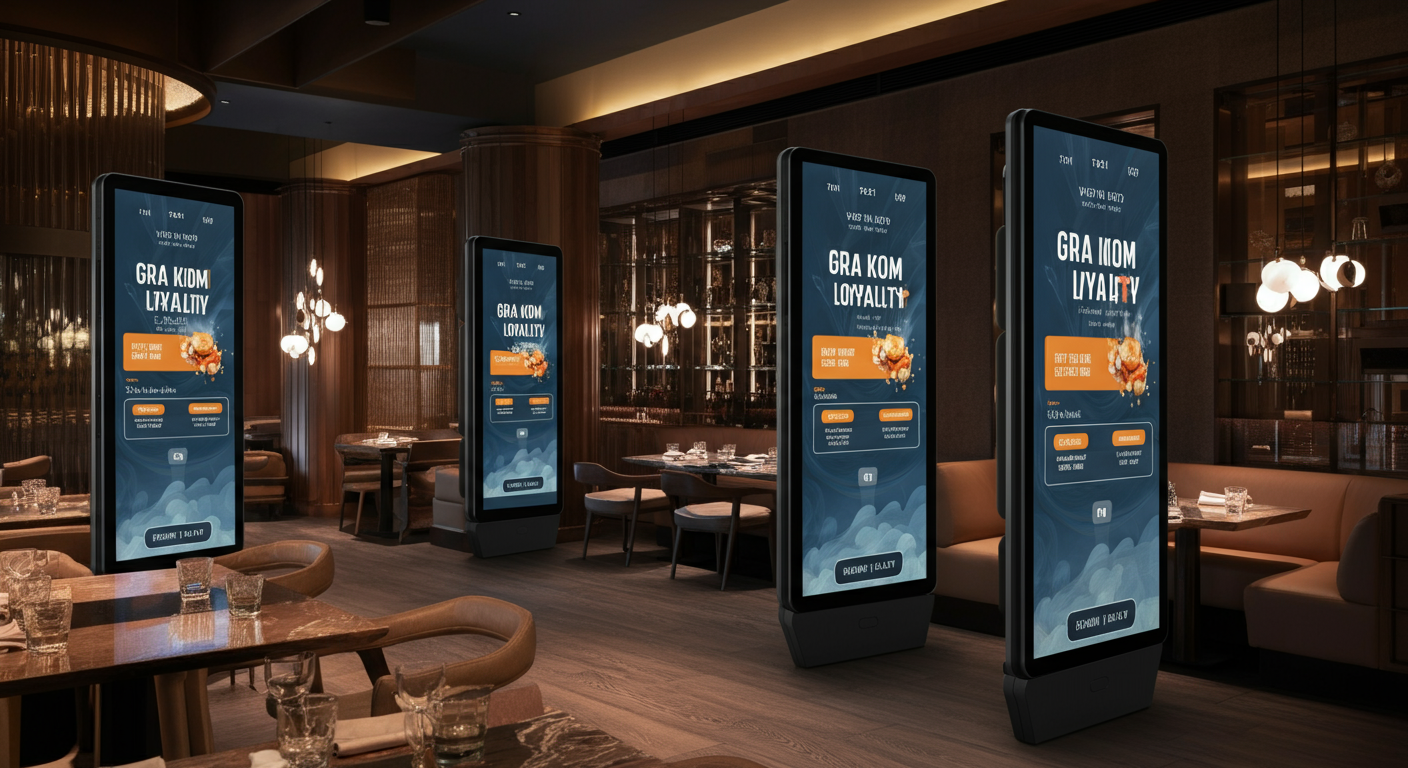Imagine walking into a bustling restaurant and being greeted not only by the enticing aroma of culinary delights but also by strategically placed screens showcasing engaging content tailored just for you. This is the power of CETV Advertising for Multi-location Restaurant Brands. In today’s competitive dining landscape, capturing and retaining customer attention is more crucial than ever, especially for brands with multiple locations striving to maintain a cohesive identity.
Commercial Environment TV (CETV) presents a unique opportunity for these brands to amplify their presence, directly engaging customers where they dine. By utilizing screens in high-traffic areas, restaurants can deliver targeted advertisements that not only capture attention but also enhance the dining experience. This approach not only boosts brand visibility but also fosters deeper customer engagement and loyalty.
For multi-location restaurant brands, the challenge lies in maintaining consistency across various sites while also catering to local tastes and preferences. CETV offers a solution by allowing brands to tailor content specific to each location, ensuring that messaging resonates with local audiences. As we delve deeper into this blog, we’ll explore how leveraging CETV can transform your advertising strategy, driving both foot traffic and customer satisfaction.
Ready to discover the future of restaurant marketing? Let’s dive into how CETV can revolutionize your brand’s presence and set you apart in a crowded market.
Understanding CETV and Its Benefits for Restaurant Brands
In the bustling world of multi-location restaurant brands, capturing customer attention is more challenging than ever. This is where Commercial Environment TV (CETV) steps in, offering a unique platform for advertising by placing screens in high-traffic areas. This innovative approach allows restaurant brands to enhance their visibility and engage customers more effectively.
By leveraging CETV, restaurants can deliver targeted advertisements that not only capture attention but also enrich the dining experience. This section explores the myriad benefits of CETV advertising for restaurant brands, drawing on examples of successful campaigns and highlighting key statistics.
What is CETV?
CETV, or Commercial Environment TV, refers to the strategic placement of television screens in commercial settings, such as restaurants, to display targeted advertisements. Unlike traditional advertising methods, CETV provides a dynamic platform for engaging content that can be tailored to specific audiences. For instance, a restaurant can showcase its daily specials during peak dining hours, ensuring that the content is relevant and timely.
This flexibility makes CETV a powerful tool for enhancing brand presence and driving customer engagement. By reaching customers at the point of decision-making, CETV increases the likelihood of conversion, making it an invaluable asset for restaurant brands.
Benefits of CETV for Restaurant Brands
Restaurant brands can reap numerous benefits from CETV advertising, including:
- Increased Brand Visibility: By placing screens in high-traffic areas, restaurants can ensure that their brand remains top-of-mind for customers.
- Enhanced Customer Engagement: Engaging content tailored to the audience can foster a deeper connection with customers, enhancing their overall dining experience.
- Targeted Advertising: CETV allows for precise targeting based on location, time, and customer demographics, ensuring that the right message reaches the right people.
- Cost-Effectiveness: Compared to traditional TV advertising, CETV offers a more affordable solution, making it accessible for brands of all sizes.
Successful CETV Campaigns in the Restaurant Industry
Several restaurant brands have successfully harnessed the power of CETV to boost their marketing efforts. For example, a well-known fast-food chain implemented a CETV campaign featuring interactive menus and promotions tailored to the time of day and customer demographics. This approach not only increased sales but also enhanced customer satisfaction by providing relevant and timely information.
Another example is a casual dining restaurant chain that used CETV to promote its loyalty program. By displaying engaging content that highlighted the benefits of membership, the brand was able to increase sign-ups and foster a sense of community among its customers. These case studies demonstrate the potential of CETV to drive brand engagement and deliver tangible results.
Strategies for Implementing CETV in Multi-location Restaurants
Implementing CETV Advertising for Multi-location Restaurant Brands requires a well-thought-out strategy to ensure maximum impact. By strategically placing screens, creating engaging content, and timing ads effectively, restaurants can enhance brand presence and customer engagement. This section will guide you through essential strategies to implement CETV successfully in your multi-location restaurant brand.
Understanding the unique needs of each location and tailoring your approach accordingly is crucial. Whether it’s a bustling downtown eatery or a cozy suburban spot, CETV can be adapted to fit the ambiance and customer base of each restaurant. Let’s explore the strategies that can help you make the most of this powerful advertising tool.
Strategic Placement of Screens
The placement of screens is a critical factor in the success of CETV advertising. Position screens in high-traffic areas where customers naturally gather, such as waiting areas, near the bar, or at the entrance. This ensures that your content captures the attention of as many patrons as possible.
Consider the layout and flow of each restaurant to determine the optimal screen locations. For instance, a screen placed near the entrance can welcome guests with promotions and specials, setting the tone for their dining experience. Additionally, screens near the bar or waiting areas can keep patrons engaged while they wait, increasing the likelihood of upselling and cross-selling opportunities.
Creating Engaging Content
Content is king when it comes to CETV advertising. Develop content that resonates with your audience by showcasing menu highlights, chef specials, and upcoming events. Use high-quality visuals and dynamic graphics to capture attention and create a memorable experience.
Incorporate interactive elements, such as polls or trivia, to engage customers and encourage participation. Tailor content to reflect local tastes and preferences, ensuring it aligns with the unique identity of each restaurant location. This personalized approach not only enhances customer engagement but also fosters a deeper connection with your brand.
Timing of Ads
Timing is everything in advertising, and CETV is no exception. Schedule ads to coincide with peak dining hours and special events to maximize visibility and impact. For example, promote lunch specials during the mid-morning hours or highlight happy hour deals in the late afternoon.
Utilize data analytics to understand customer behavior and adjust ad schedules accordingly. By aligning ad timing with customer patterns, you can ensure that your messaging reaches the right audience at the right time, enhancing the effectiveness of your CETV campaigns.
By following these strategies, multi-location restaurant brands can effectively implement CETV advertising to boost brand presence and customer engagement. For more insights and strategies on leveraging CETV for your business, visit CETV Now.
Integrating CETV with Broader Marketing Strategies
In today’s competitive restaurant industry, integrating CETV Advertising for Multi-location Restaurant Brands with broader marketing strategies is crucial for maximizing impact. By aligning CETV with other marketing efforts, restaurant brands can create a cohesive and powerful brand presence that resonates with their target audience. This section explores how to effectively integrate CETV with existing marketing strategies to achieve optimal results.
As brands strive to capture consumer attention, CETV offers a unique opportunity to engage customers directly at the point of decision-making. By combining CETV with digital marketing, social media, and other traditional advertising channels, businesses can enhance their reach and influence consumer behavior more effectively.
The Synergy Between CETV and Digital Marketing
Digital marketing and CETV can work hand-in-hand to create a seamless customer experience. By leveraging data from digital platforms, brands can tailor their CETV content to reflect current trends and consumer preferences. For instance, a restaurant might use data from its social media channels to identify popular menu items and then promote these items through targeted CETV ads during peak dining hours.
Moreover, integrating CETV with digital marketing allows for real-time updates and adjustments. Brands can quickly respond to market changes or consumer feedback by updating their CETV content, ensuring that their messaging remains relevant and engaging. This dynamic approach not only enhances brand visibility but also fosters a deeper connection with the audience.
Examples of Integrated Marketing Campaigns
Successful integrated marketing campaigns often combine CETV with other channels to create a unified brand message. For example, a restaurant chain might launch a campaign that includes CETV ads promoting a seasonal menu, complemented by email newsletters and social media posts. This multi-channel approach ensures that the message reaches consumers through various touchpoints, increasing the likelihood of engagement and conversion.
Another example is a restaurant chain that uses CETV to showcase new menu items while simultaneously running a digital campaign offering exclusive online discounts. By integrating these efforts, the brand can drive both in-store visits and online orders, maximizing its reach and impact.
Case Studies and Comparative Analysis
Case studies provide valuable insights into how brands can successfully integrate CETV with broader marketing strategies. For instance, a well-known fast-food chain implemented a CETV campaign that featured interactive menus and promotions tailored to the time of day and customer demographics. This approach not only increased sales but also enhanced customer satisfaction by providing relevant and timely information.
Comparative analysis of different campaigns can also reveal best practices and areas for improvement. By examining the strategies of successful brands, businesses can identify key elements that contribute to effective CETV integration, such as content personalization, strategic timing, and cross-channel consistency.
For more insights and strategies on leveraging CETV for your business, visit CETV Now.
Harnessing CETV for Restaurant Brand Success
As we conclude our exploration of CETV Advertising for Multi-location Restaurant Brands, it’s clear that this innovative approach offers a multitude of benefits for enhancing brand presence and customer engagement. By strategically placing screens in high-traffic areas, restaurants can deliver targeted advertisements that not only capture attention but also enrich the dining experience.
Throughout this blog, we’ve delved into the key strategies for effectively implementing CETV in multi-location restaurants. Here are some essential takeaways:
- Strategic Screen Placement: Position screens in areas with high foot traffic to maximize visibility and engagement.
- Engaging Content Creation: Develop dynamic and visually appealing content that resonates with your audience.
- Timing of Ads: Schedule advertisements during peak dining hours to ensure maximum impact.
- Integration with Broader Marketing Strategies: Align CETV efforts with digital and traditional marketing channels for a cohesive brand message.
These strategies not only boost brand visibility but also foster a deeper connection with customers, enhancing loyalty and driving sales. The synergy between CETV and other marketing channels creates a powerful platform for storytelling and customer engagement.
Ready to elevate your restaurant brand with CETV? We invite you to explore the potential of this dynamic advertising medium by visiting CETV Now. Discover how you can leverage CETV to transform your marketing strategy and achieve remarkable results.
Have questions or want to share your thoughts? Join the conversation in the comments below and connect with others who are exploring the future of restaurant marketing.









